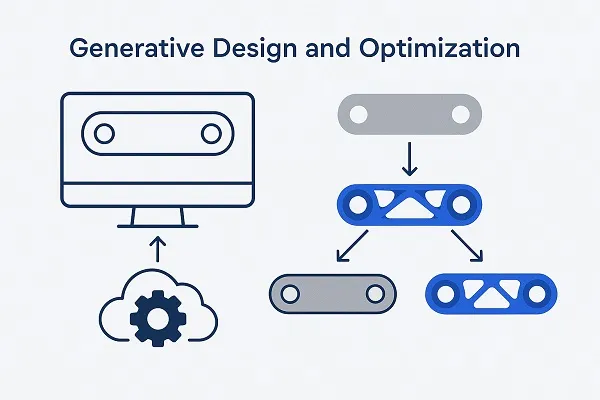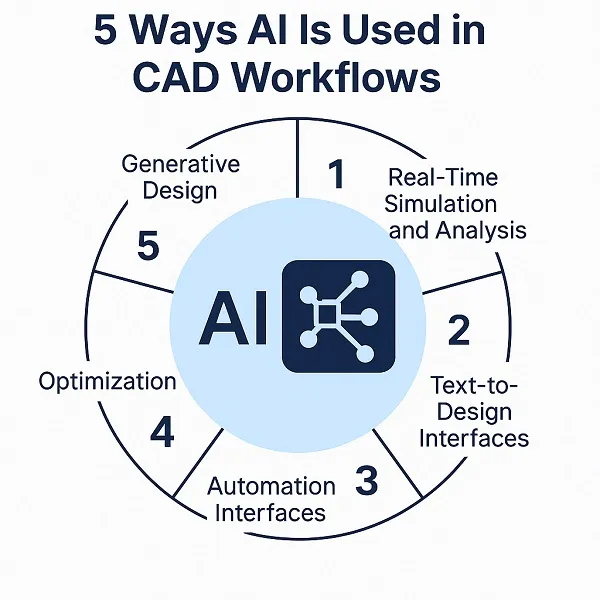Artificial intelligence (AI) is increasingly being integrated into computer-aided engineering (CAE) and computer-aided architectural engineering (CAAE) to enhance efficiency, accuracy, and innovation in design workflows. AI-driven tools are not only accelerating model generation but also transforming how engineers and architects approach problem-solving. From generative design to real-time simulation, AI is rapidly becoming a foundational layer in the next generation of CAD-based engineering systems.
Generative Design and Optimization

One of the most significant AI contributions to CAD-based engineering is generative design. These systems use algorithms to generate a multitude of design alternatives based on defined constraints (materials, load conditions, budget, etc.). Autodesk’s Fusion 360 and Bentley’s generative components are prominent examples. Engineers and architects can explore options that might be missed using traditional manual modeling.
Generative design enables rapid iteration, often guided by performance simulations and feedback loops, dramatically reducing the time required for early-phase decision-making. It is particularly valuable in:
- Structural optimization (e.g., bridges, trusses)
- HVAC layout planning
- Product design for weight or material reduction
Popular tools include:
- Autodesk Fusion 360
- Rhino with Grasshopper
- SolidWorks with topology optimization plugins
- Bentley GenerativeComponents
These tools allow designers to balance competing constraints and produce efficient, sometimes novel, solutions.
Real-Time Simulation and Analysis

AI models are increasingly being used to simulate physical behaviors (e.g., stress, heat flow, airflow) in real time or near real time, providing immediate feedback during the design process. For instance, NVIDIA’s Omniverse and Autodesk’s Insight tools integrate physics-based modeling with AI enhancements to allow quicker adjustments and on-the-fly optimizations.
These systems help engineers test thousands of micro-adjustments without rerunning full simulation cycles. Real-time analysis is especially impactful in:
- Automotive crash simulation
- Building energy modeling
- Lighting and acoustic planning in architecture
Benefits include:
- Faster iteration cycles
- Reduced reliance on external simulation teams
- Lower hardware demands through GPU/cloud acceleration
Text-to-Design and Automation Interfaces

New AI-powered interfaces, including natural language processing and visual recognition, are beginning to shape how users interact with CAD systems. Emerging platforms are experimenting with text-to-design functions, where users can input instructions like “design a cantilevered structure with steel trusses” and receive parametric model suggestions.
These tools can streamline design workflows by:
- Automating repetitive tasks (e.g., labeling, tagging, annotation)
- Populating views and sheets from templates
- Interpreting design prompts using natural language
Examples of tools and initiatives include:
- Autodesk Forma (conceptual design via AI)
- NVIDIA ACE (AI-assisted design interaction)
- Custom GPT integrations with BIM platforms
Benefits and Considerations
Integrating AI into CAD and CAE workflows delivers substantial benefits:
- Faster design cycles and fewer manual adjustments
- Enhanced model performance through iterative optimization
- Early-stage energy and material efficiency feedback
- Better integration between design and simulation environments
However, there are still limitations. AI outputs can be opaque or biased based on training data. They also require skilled professionals to interpret results and validate the technical accuracy of the suggestions.
Future Outlook
As the technology matures, we can expect greater convergence between AI, CAD, and Building Information Modeling (BIM). Cloud-based AI engines may become embedded in standard design platforms, while AI-driven collaboration tools will enable global design teams to work seamlessly in real time.
For organizations adopting these technologies, talent readiness becomes critical. Engineers, architects, and designers will need to pair domain expertise with literacy in machine learning-assisted tools to fully leverage the power of AI-enhanced design.
References
- Autodesk. (2023). Generative Design in Fusion 360. https://www.autodesk.com/solutions/generative-design
- NVIDIA. (2024). Omniverse Platform Overview. https://developer.nvidia.com/nvidia-omniverse-platform
- Deloitte. (2023). AI in Engineering: Emerging Use Cases. https://www2.deloitte.com/insights/us/en/focus/tech-trends/2023/ai-in-engineering.html
- ASME. (2022). The Role of Artificial Intelligence in CAD. https://www.asme.org/topics-resources/content/the-role-of-ai-in-cad
Content reviewed and published by Tier2Tek Staffing Editorial Team .

